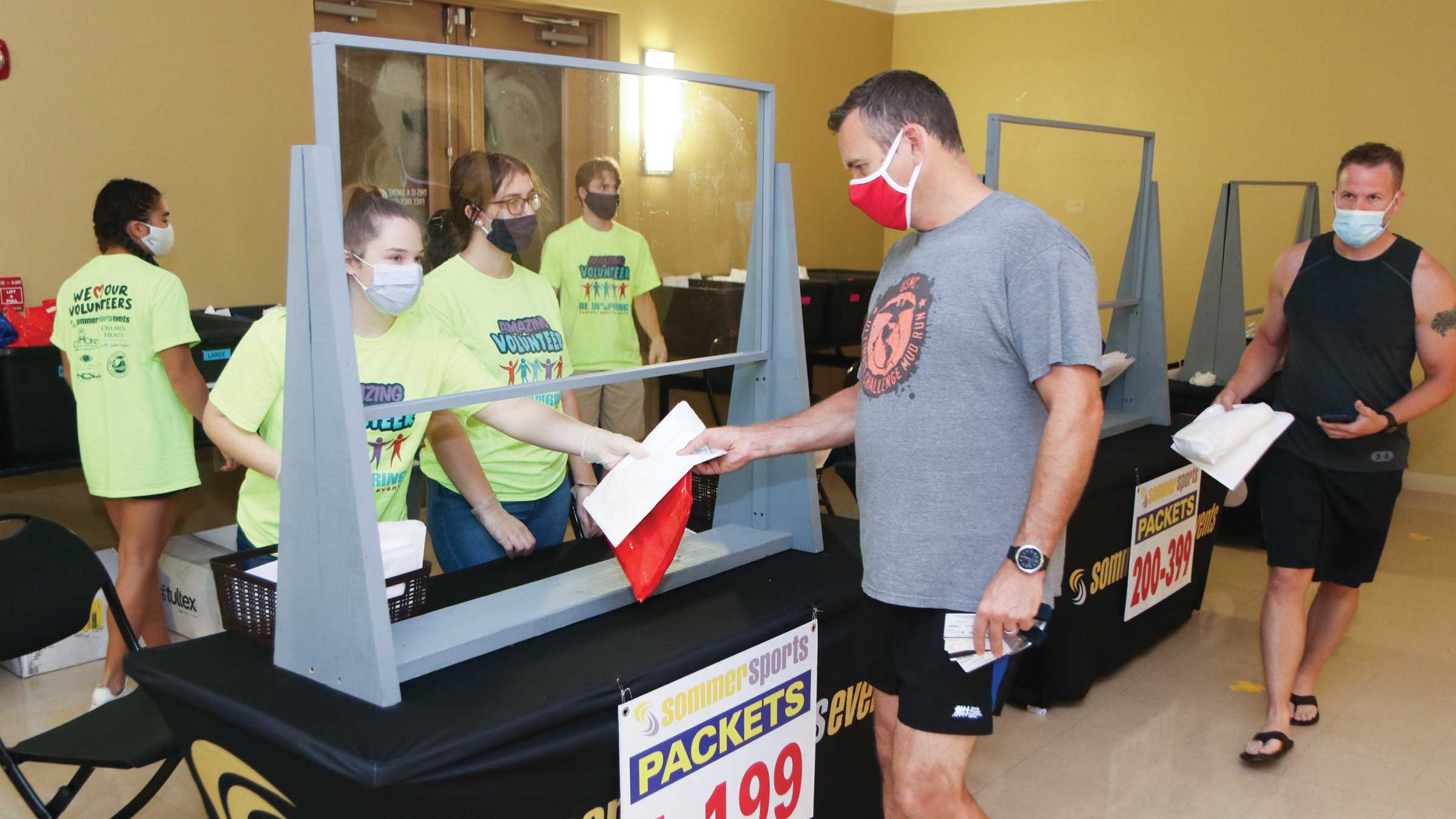Special Report: Stay Local, Race Local

Packet pickup looks a little different when checking in for races during the pandemic. (Photo: Sommer Sports)
Although COVID-19 public health guidelines continue to vary around the globe, a few common themes have emerged—travel is restricted, large gatherings are capped, and there are widespread bans or cancellations of mass participation events. All of which obviously makes it impossible for large-scale triathlons to take place. Triathletes aren’t able to travel to faraway races and, even if they could, there aren’t many races to travel to anyway.
“There aren’t many options for big races to be held,” said Tim Yount, USA Triathlon’s chief sport development officer.
Because of these limitations, many of the first races that return in the post-COVID-19 era will be local and small. And with large events, like the New York City Marathon and the Ironman World Championship off the table for 2020, this could mean a chance for these local grassroots races to enjoy a renaissance, as athletes look for any chance to get to a start line.
“I’m optimistic about the resurgence of local races and what that might look like,” said Gabriela Gallegos, head of Race El Paso, which puts on six smaller races. Athletes, she said, are chomping at the bit to get back in a safe way, and “I think local races are going to be the first step in that.”
Yount agrees and has the data to back it up.
According to a USAT survey conducted on a sample group of a few dozen triathletes over four weeks, the vast majority said they plan to drive to their races this year. The survey respondents also had concerns about larger races and larger crowds—and, interestingly, port-a-potty cleanliness. But over 70% did plan to get back to racing in 2020—it just might be different kinds of races.
We just don't even know right now which race directors are going to survive.
A Chance to Explore
During this pandemic, many people have used any opportunity they can to get outside and explore. Bike sales have skyrocketed and new runners and hikers are flocking to trails in unprecedented numbers.
Yount believes this might be an opportunity for some of the smaller race directors to add a gravel ride or a trail run or a beginner duathlon to their event repertoire. As athletes look for socially distanced opportunities to race, an ultra run or gravel bike ride sounds just about right.
Some of this shift towards more grassroots racing was already happening, said Lance Panigutti, the race director for Without Limits, which puts on 35 small events around Colorado from weekday “stroke and strides” to one of the first gravel triathlons in the state.
In the last couple of years, he said, “it felt like a shift in the sport,” with more focus on grassroots racing, more people coming out on mountain bikes or whatever they had in their garage. That now will likely be “accelerated,” he said, as people look for something small, local, and fun to get them outside and keep them moving.
When the economy was in a recession post-2008, Panigutti said the mid-week smaller events were more popular—a trend that shifted and moved towards destination events as the economy improved. Now that the country’s going through an economic crash, “I assume we’ll see that again,” he said.
Carry It Across The Line
The challenge, of course, is that the economic downturn is also deeply impacting many of these smaller race directors—lots of whom do it as a side gig and don’t have the cash flow to make it through this year. “We just don’t even know right now which race directors are going to survive,” Yount said.
Yount added that as these race directors try to get races going again, the biggest concern is crafting a safety plan that will be accepted by the local governing agencies when there are still so many unknowns. Because of those unknowns, said Gallegos, it’s hard to front the money on permits or T-shirts when you don’t have registration fees coming in and the race might then not be able to happen. Amenities that require a financial outlay from the director are riskier than ever.
And for these smaller mom-and-pop set-ups, navigating these new hurdles is an added layer of stress—figuring out how to conduct temperature checks or ordering social-distancing signs. (Panigutti said another local race director has already suggested sharing some of those resources, like signs.) For a smaller operation, there is less that needs to be done, but it can still be a lot for a one-man-band in the midst of everything else going on.
Stephen Del Monte, who runs DelMo Sports, sees behind-the-scenes on both the smaller and bigger events. He runs Ironman 70.3 Atlantic City, but he also puts on his own local races—both large and small. The level of planning a big company, like Ironman, has at its disposal dwarfs some of the tiny races, he said. “I would feel safer racing with an organization that has staff and a plan.”
But what he’s also hearing from his athletes is excitement about getting back to racing and understanding that there may be some hiccups in the process.
Yount said that once race directors are through that initial hump, they’re finding—at the small races that have occurred so far—that there is more appreciation and joy than ever, and less concern about some of the swag and extra perks. For athletes, this might be the chance to finally try that fun local adventure or small grassroots race you never got around to before—and simply be thankful for every minute of it.